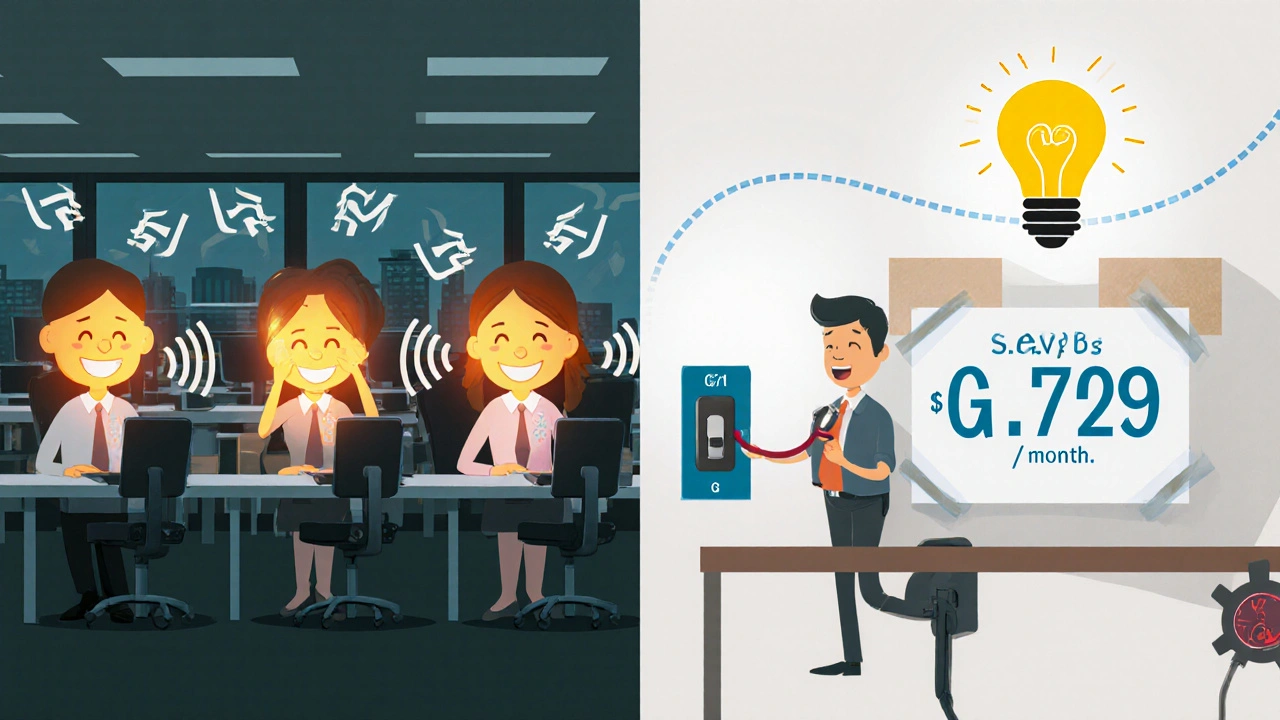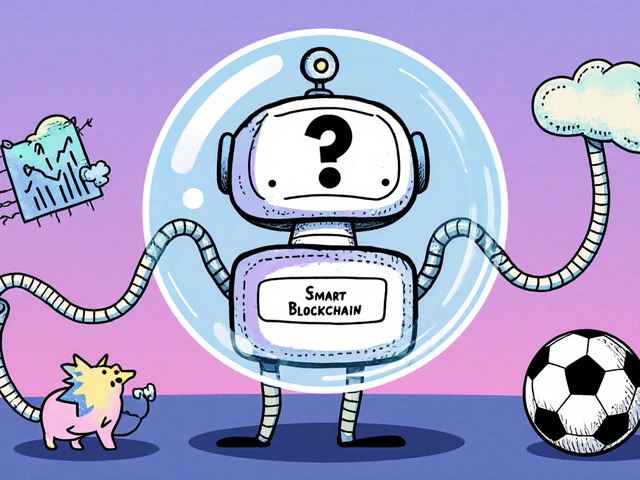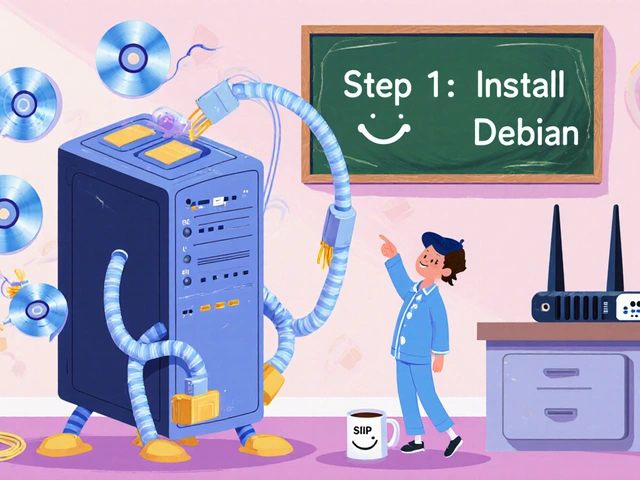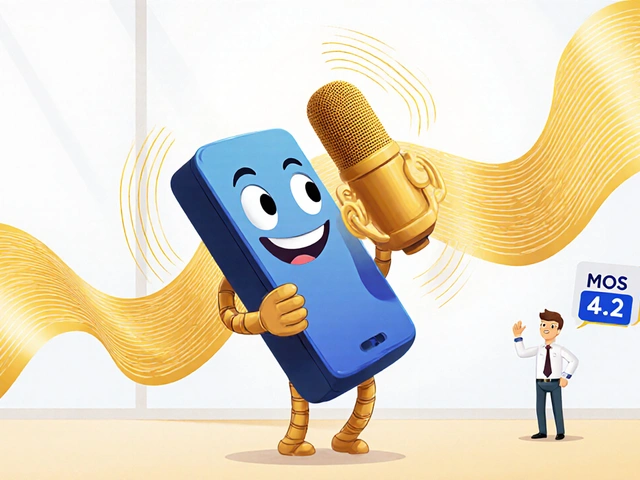Why Bandwidth Per Call Matters in VoIP
When you make a call over the internet, your voice gets turned into digital data. That data needs to travel across your network. The more data each call uses, the more bandwidth it eats up. If you run a business with dozens or hundreds of phones, that adds up fast. Two codecs dominate this space: G.711 and G.729. They do the same job-carry voice-but they do it in completely different ways. Choosing the wrong one can mean poor call quality, slow networks, or surprise licensing bills.
G.711: The Gold Standard for Voice Quality
G.711 has been around since 1972. It’s the same codec used in traditional landline phones. It doesn’t compress your voice at all. That means every second of your call uses 64 kbps of raw bandwidth. Add in the headers from IP, UDP, and RTP protocols, and you’re looking at about 80 kbps per call. That sounds like a lot, but it’s why G.711 sounds so clear. The Mean Opinion Score (MOS) for G.711 is 4.2 out of 5-just below perfect. People don’t notice it’s over the internet. They think they’re on a regular phone.
Enterprise call centers rely on G.711 because every word matters. A 500-agent contact center switched from G.729 to G.711 and saw a 12% drop in customer complaints. Why? Because G.711 doesn’t distort speech. It doesn’t make ‘s’ sounds hiss or ‘b’ sounds disappear. It’s uncompressed, so it handles background noise and accents better. And it’s royalty-free. No hidden fees. No licensing paperwork.
G.729: The Bandwidth Saver
G.729 cuts bandwidth use by 87%. Instead of 64 kbps, it uses just 8 kbps of raw data. With headers, that’s about 32 kbps per call. That’s the difference between using a full tank of gas for a 10-mile trip versus using a quarter tank. For companies making international calls, this matters. A business with 100 concurrent calls using G.711 needs 8 Mbps of bandwidth. Switch to G.729? Only 3.2 Mbps. That’s a 60% reduction.
That’s why 78% of enterprises use G.729 for international trunking, according to Telnyx’s 2024 data. One company saved $2,800 a month just by switching their trans-Pacific calls to G.729. In emerging markets, where bandwidth costs $1,200 per Mbps/month, G.729 isn’t optional-it’s survival.
But there’s a trade-off. G.729’s MOS is 4.0. That’s still good-above the ‘toll quality’ threshold. But it’s not perfect. Voices can sound slightly robotic, especially under stress. And if your call goes through multiple systems that convert the codec (transcoding), quality drops fast. One network engineer reported G.729’s MOS falling from 4.0 to 2.8 after three hops. That’s unusable.
Real-World Bandwidth Needs: The Math
Let’s say you have five simultaneous calls. Here’s what you actually need:
- G.711: 80 kbps per call × 5 = 400 kbps total (rounded to 512 kbps in practice)
- G.729: 32 kbps per call × 5 = 160 kbps total (rounded to 200 kbps in practice)
That’s more than double the number of calls you can handle on the same network. If your internet connection is 10 Mbps, you can run about 125 G.711 calls. With G.729? Around 312. That’s the power of compression.
But don’t forget the formula: Codec bitrate + (packet rate × 40 bytes × 8 bits). Most systems use 20ms packets. That’s 50 packets per second. So for G.729: 8 kbps + (50 × 320 bits) = 8 kbps + 16 kbps = 24 kbps raw. Add header padding and jitter buffers, and you land at 32 kbps. Always plan for overhead.

Processing Power: The Hidden Cost
G.711 is simple. It doesn’t need much CPU. Your phone or server can handle thousands of calls without breaking a sweat. G.729? It’s a different story. It uses complex math to squeeze your voice into 8 kbps. That takes processing power.
Lightyear.ai’s 2024 benchmark showed G.729 uses 1.8 times more CPU than G.711 for the same number of calls. So if your server can handle 100 G.711 calls, it might only manage 55 G.729 calls before it hits its limit. That means you need more servers-or more powerful ones-to run the same number of G.729 calls. That’s a hidden cost you won’t see on your bandwidth bill.
And if you’re using AI voice agents, transcription tools, or real-time translation? G.729’s compression makes those tools struggle. G.711’s clean signal is much easier for AI to understand.
Licensing: The Silent Bill
G.711 is free. Always has been. G.729? Not so much. You need a license. Cisco charges about $50 per endpoint. Other vendors range from $40 to $75. For a company with 500 phones, that’s $25,000 in licensing fees. Most of the time, it’s buried in your hardware cost. You don’t see it. But if you switch vendors or add phones later, you’ll get a surprise invoice.
That’s why 32% of negative reviews on VoIP providers mention unexpected G.729 licensing fees. One company thought they were getting a ‘low-cost’ VoIP system-until they got the bill for 200 licenses. Always ask: ‘Is G.729 licensed? How much?’ before signing a contract.
Who Should Use Which Codec?
Here’s a simple guide:
- Use G.711 if: You’re in a call center, your network has plenty of bandwidth, you’re making internal calls, or audio clarity is critical. Also use it if you want to avoid licensing fees.
- Use G.729 if: You’re making international calls, your bandwidth is limited or expensive, you’re a small business with a tight budget, or you’re in a region where bandwidth costs over $1,000 per Mbps/month.
Most large companies use both. They run G.711 for internal calls and G.729 for outbound international lines. Cisco’s own design guide says: use G.711 on LANs with over 100 Mbps per 100 users, and G.729 on WAN links under 1.5 Mbps.

What’s Next? The Future of VoIP Codecs
G.711 and G.729 aren’t going away anytime soon. Gartner predicts they’ll still make up 85% of VoIP traffic through 2027. But new codecs are coming. Opus is royalty-free, handles wideband audio, and adapts bandwidth on the fly. EVS (Enhanced Voice Services) is even better-used in 5G networks. But they need modern hardware and aren’t compatible with old phones.
Right now, G.711 and G.729 are the universal languages of VoIP. Every phone, every system, every provider supports them. That’s why they stick around. Even if you upgrade to Opus later, you’ll still need to understand these two.
Troubleshooting Common Issues
Problems with G.711 and G.729 usually come down to mismatched settings.
- Call drops or static? Check if your call manager and session border controller are set to the same codec. 47% of VoIP issues come from mismatched codec configurations.
- Call quality gets worse over time? You’re likely transcoding. Avoid routing calls through multiple systems that convert G.729 to G.711 and back. Each conversion degrades quality.
- How do I check what codec is being used? On Cisco IP phones, press the ‘?’ button twice during a call. It’ll show you the active codec.
- Is my network fast enough? Run a bandwidth test. If you’re using G.711 and your upload speed is under 5 Mbps, you’re risking poor call quality with more than 50 concurrent calls.
Final Decision: Quality or Cost?
There’s no single right answer. It’s a trade-off. G.711 gives you perfect sound. G.729 gives you lower costs and more calls on the same network. If you’re a small business with a slow internet connection, G.729 is your friend. If you’re a call center where every ‘thank you’ needs to sound clear, G.711 is non-negotiable.
Most businesses use both. They don’t have to choose one forever. Modern VoIP systems let you set codec preferences per location, per region, or per call type. Use G.711 inside your office. Use G.729 for calls to India, Brazil, or Nigeria. That’s smart. That’s efficient.
Is G.711 better than G.729 for voice quality?
Yes, G.711 has slightly better audio quality with a MOS score of 4.2 compared to G.729’s 4.0. G.711 is uncompressed, so it preserves the full range of human speech. G.729 compresses the signal, which can make voices sound a bit robotic or muffled, especially after multiple transcoding hops. For call centers or high-stakes conversations, G.711 is the clear winner.
How much bandwidth does G.729 actually use per call?
G.729 uses 8 kbps of raw audio data. But with IP, UDP, and RTP headers, total bandwidth per call is typically 32 kbps when using 20ms packets. If you increase packet size to 40ms, you can reduce bandwidth to 16 kbps. Always plan for 30-35 kbps per call to account for network overhead and jitter buffers.
Do I need to pay for G.729 licensing?
Yes. G.729 requires a license from the patent holder, usually bundled into hardware or software costs. Prices range from $40 to $75 per endpoint. G.711 is royalty-free. Always confirm licensing costs before deploying G.729-many businesses are surprised when they get the bill for hundreds of licenses.
Can I use G.711 and G.729 together in the same system?
Absolutely. Most enterprise VoIP systems support multiple codecs and let you assign them by location or call type. For example, use G.711 for internal calls and G.729 for international trunks. This gives you the best of both: quality where it matters, savings where you need them.
Will G.729 be replaced soon by newer codecs?
Not soon. While newer codecs like Opus and EVS offer better quality and are royalty-free, G.729 remains the most widely supported narrowband codec globally. Its 8:1 compression ratio is unmatched in cost-sensitive markets. Gartner predicts G.711 and G.729 will still handle 85% of VoIP traffic through 2027. They’re not going away.
Which codec uses less CPU: G.711 or G.729?
G.711 uses far less CPU because it doesn’t compress audio. G.729 requires complex algorithms to compress and decompress voice, using about 1.8 times more processing power. This means your server can handle fewer G.729 calls before hitting CPU limits. For large deployments, this impacts hardware costs.









Adrienne Temple
4 Nov 2025 at 20:22G.711 is just *so* much nicer to listen to, honestly. 🙌 I used to work in a call center where they tried to save money with G.729 and half the customers thought we were robots. Like, 'Thank you for calling' sounded like a glitchy Siri. G.711? Clear. Human. No confusion. Worth every bit of bandwidth.